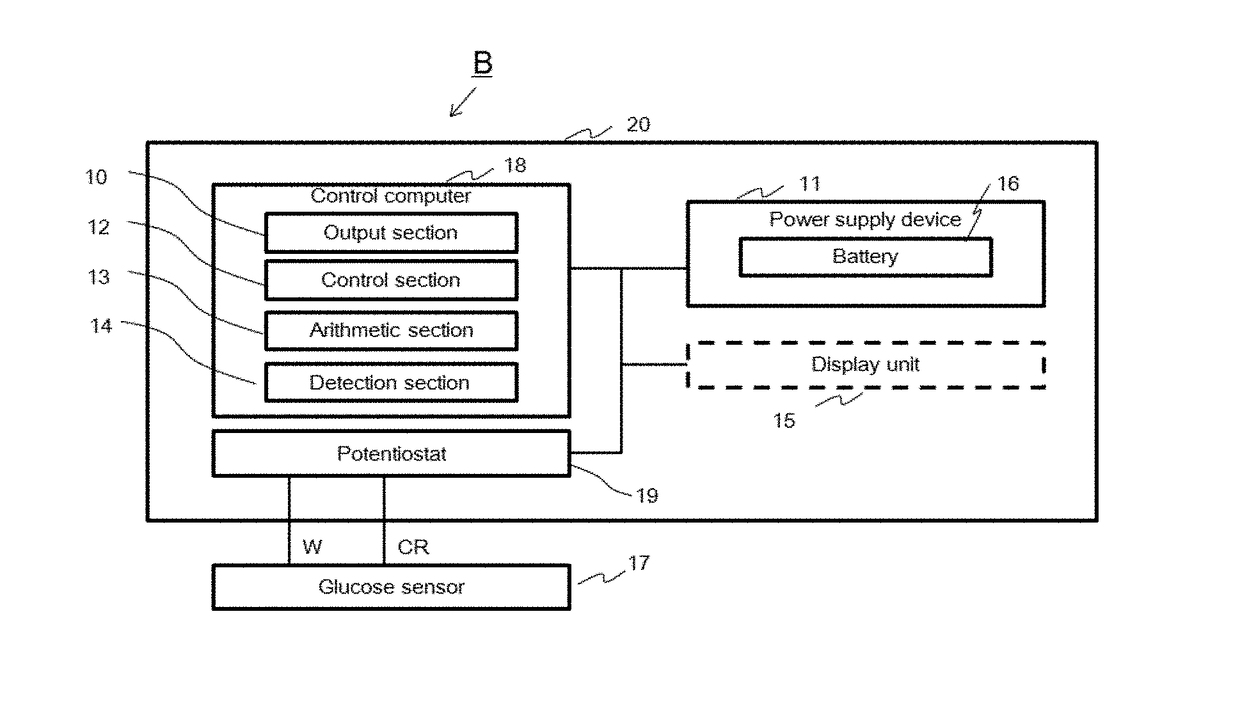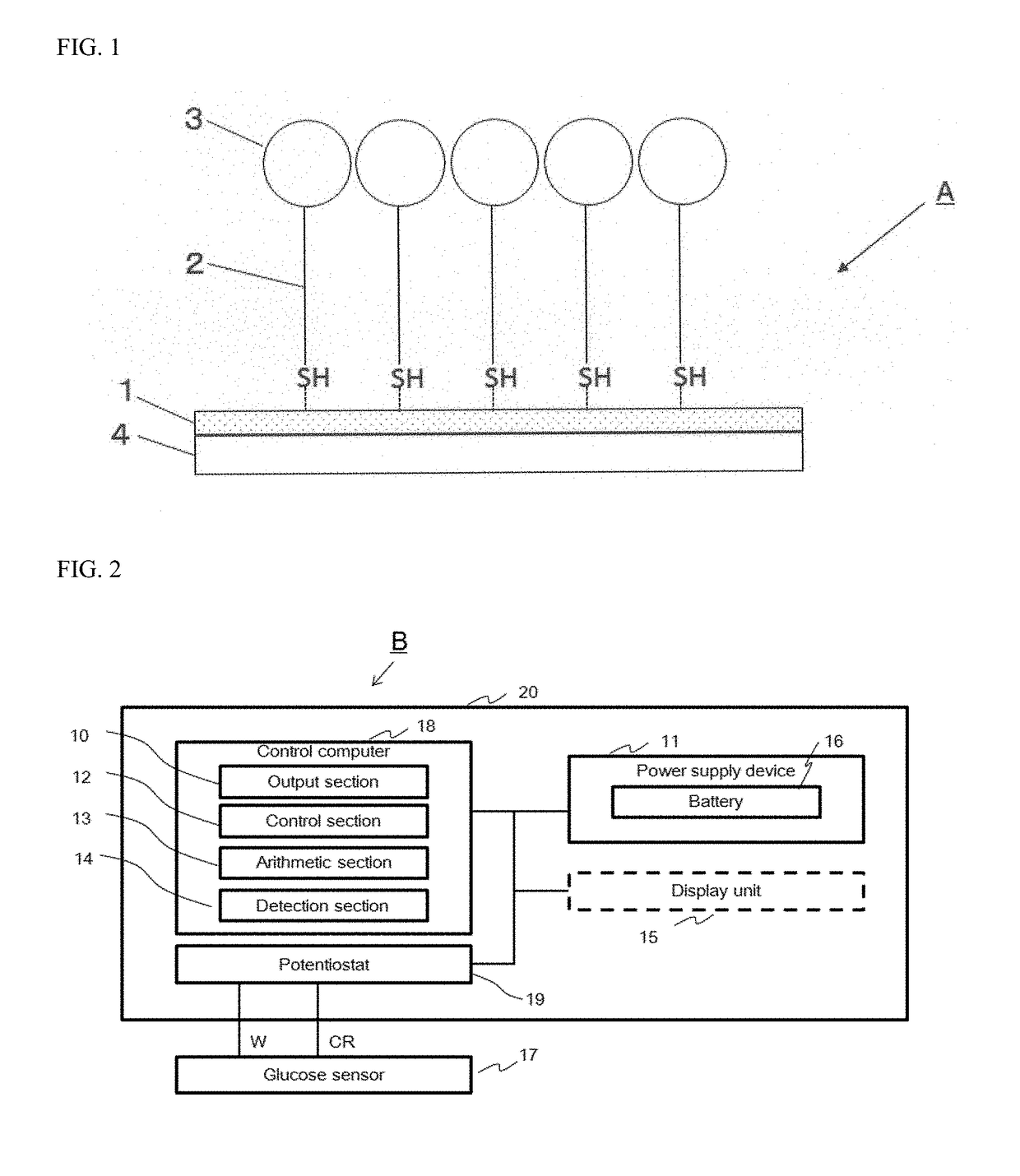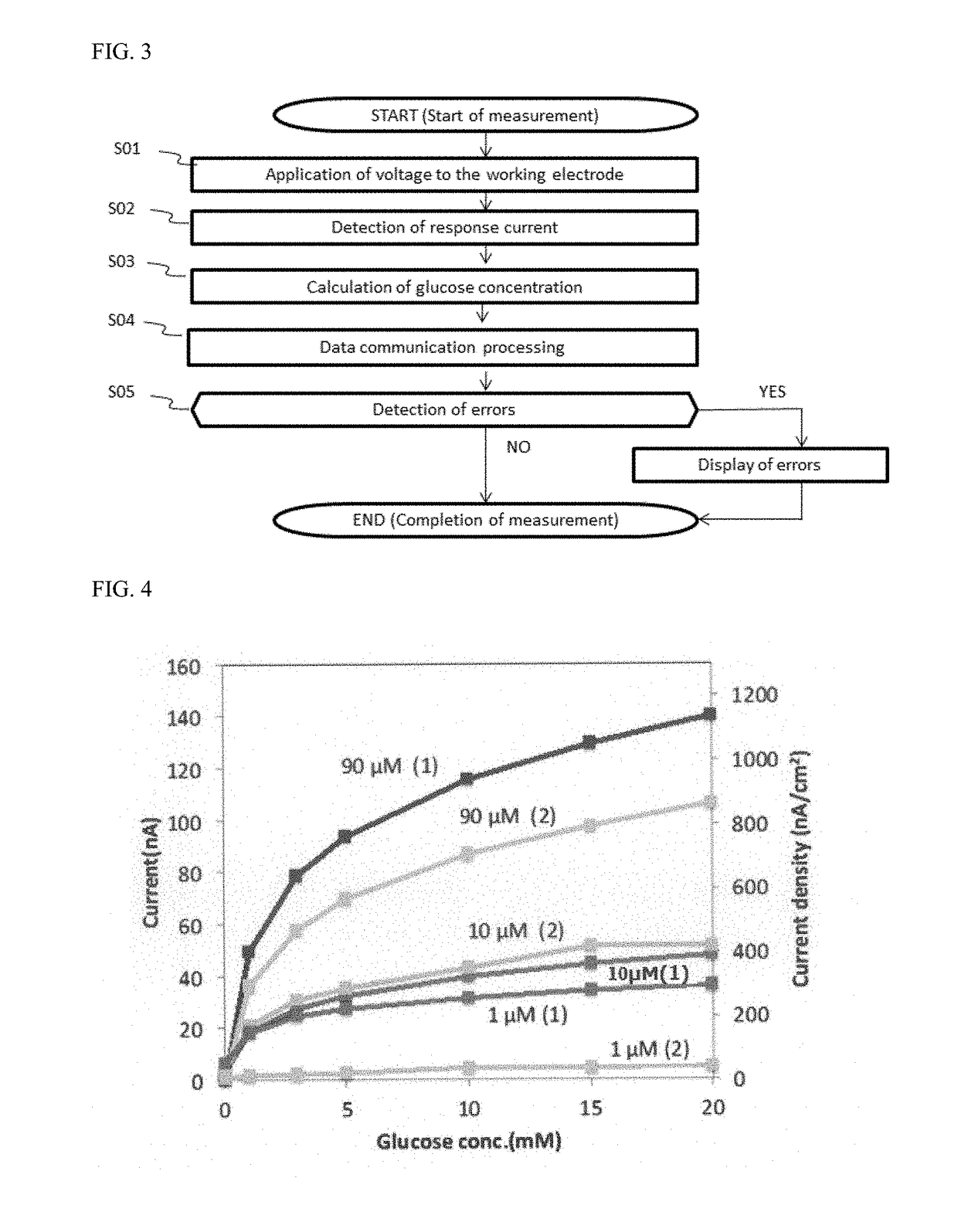Enzyme Electrode and Biosensor Using the Same
a biosensor and enzyme electrode technology, applied in the field of enzyme electrodes, can solve the problem of smaller response value than the response value expected from the fixed amount of enzymes, and achieve the effect of improving the response current value of the enzyme electrode, increasing the amount of enzymes to be immobilized in the part close to the active center of the enzyme, and improving the electron transfer efficiency between the enzyme and the current collector
- Summary
- Abstract
- Description
- Claims
- Application Information
AI Technical Summary
Benefits of technology
Problems solved by technology
Method used
Image
Examples
example 1
(Preparation of Enzyme Electrode)
[0066]An enzyme electrode was prepared by immobilizing GDH containing cytochrome C subunit on the gold surface via a monolayer-forming molecule. As the monolayer-forming molecule, the following DSH was used.
[0067]Specifically, a gold wire (3 mm in tip) was immersed in a Piranha solution (200 μl) at room temperature overnight, then washed with acetone, immersed in a DSH solution in acetone (concentration 1 μM, 10 μM or 90 μM) and incubated at 25° C. for 8 hours to allow thiol group of DSH to bind to the gold surface. Subsequently, it was washed with acetone, immersed in HEPES (100 μl) containing an enzyme (FADGDH derived from Burkholderia cepacia (concentration 0.028 mg / ml)) and incubated at 4° C. for 2 hours to allow the enzyme to bind via a functional group of DSH to obtain an enzyme electrode.
(Measurement of Glucose Concentration)
[0068]The response current value for 0 mM (background), 1 mM, 3 mM, 5 mM, 10 mM, 15 mM, or 20 mM aqueous solution of glu...
example 2
(Preparation of Enzyme Electrode)
[0070]In order to confirm the difference in direct electron transfer efficiency due to the presence or absence of monolayer-forming molecule, the responses of the electrode prepared without monolayer-forming molecule and the electrode prepared with monolayer-forming molecule were compared. Specifically, for the electrode without the monolayer-forming molecule, a gold wire (3 mm in tip) was immersed in a Piranha solution (200 μl) at room temperature overnight, then washed with acetone, immersed in HEPES (100 μl) containing an enzyme (FADGDH derived from Burkholderia cepacia (concentration 0.028 mg / ml)), and incubated at 4° C. for 2 hours to allow the enzyme to be adsorbed onto the gold surface to obtain an enzyme electrode. For the electrode with the monolayer-forming molecule, the electrode was prepared in the same process as the above-described process except that after washing with acetone after the treatment with a Piranha solution, the resultant ...
example 3
(Preparation of Enzyme Electrode)
[0073]In order to confirm the difference in direct electron transfer efficiency due to the spacer length of the monolayer, an enzyme electrode on which GDH containing cytochrome C subunit was immobilized on the gold surface via each monolayer-forming molecule was prepared. As the monolayer-forming molecule, the following DSH, DSO (Dithiobis(succinimidyl octanoate)) or DSU (Dithiobis(succinimidyl undecanoate)) was used.
TABLE 1Name of CompoundStructural Formula2 X spacer length (Å)Dithiobis(succinimidyl hexanoate)16.6-17.6Dithiobis(succinimidyl octanoate)21.8-22.8Dithiobis(succinimidyl undecanoate)29.7-30.7
Specifically, a gold wire (3 mm in tip) was immersed in a Piranha solution (200 μl) at room temperature overnight, then washed with acetone, immersed in each monolayer-forming molecule solution in acetone (concentration 10 μM) and incubated at 25° C. for 24 hours to allow thiol group of DSH to bind to the gold surface. Subsequently, the resultant ele...
PUM
| Property | Measurement | Unit |
|---|---|---|
| voltage | aaaaa | aaaaa |
| charge | aaaaa | aaaaa |
| concentration | aaaaa | aaaaa |
Abstract
Description
Claims
Application Information
 Login to View More
Login to View More - R&D
- Intellectual Property
- Life Sciences
- Materials
- Tech Scout
- Unparalleled Data Quality
- Higher Quality Content
- 60% Fewer Hallucinations
Browse by: Latest US Patents, China's latest patents, Technical Efficacy Thesaurus, Application Domain, Technology Topic, Popular Technical Reports.
© 2025 PatSnap. All rights reserved.Legal|Privacy policy|Modern Slavery Act Transparency Statement|Sitemap|About US| Contact US: help@patsnap.com



